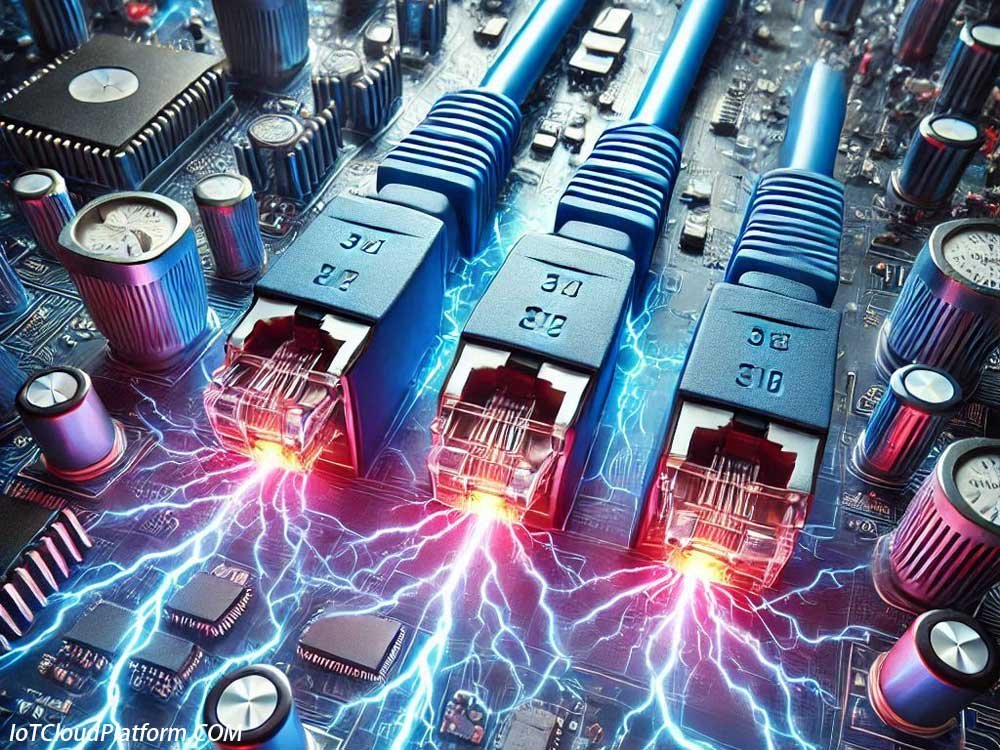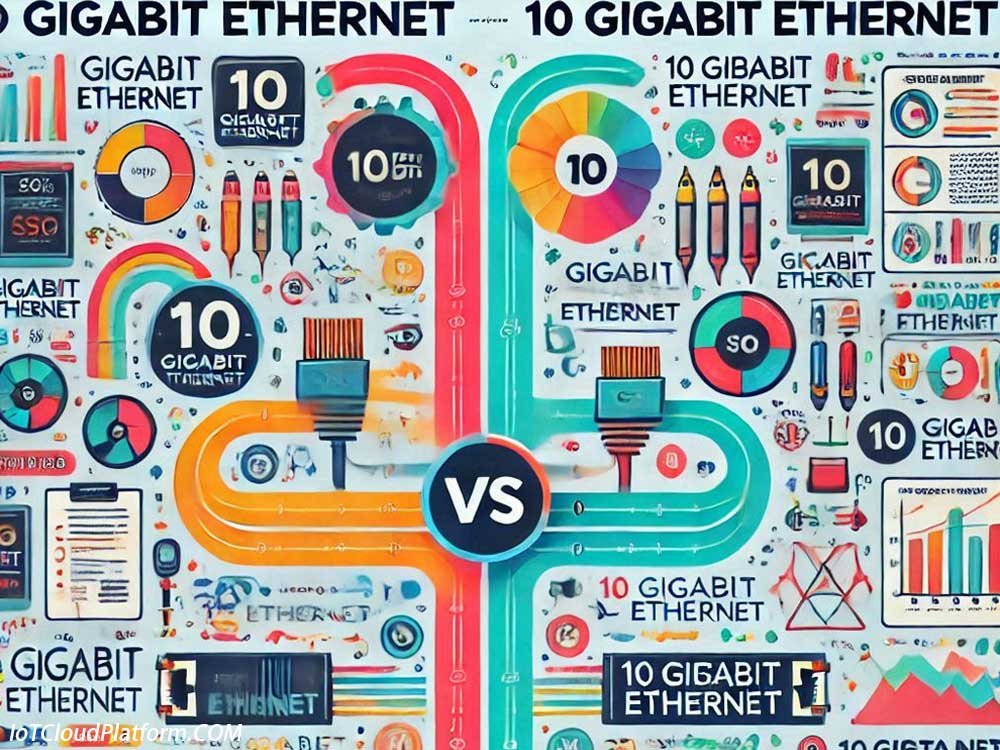
What is the Voltage Level Standard for Gigabit Ethernet?
The voltage level standard for Gigabit Ethernet is not the main parameter that directly describes the performance of network transmission, but it plays a key role in ensuring the stable operation of network equipment and the reliability of data transmission.
The following will comprehensively analyze the relevant voltage parameters of Gigabit Ethernet and their importance in network communications.
Overview of Gigabit Ethernet
Gigabit Ethernet is a network transmission standard with a transmission rate of up to 1000Mbps (i.e. 1Gbps), which is much higher than the early Ethernet standard. It is widely used in local area networks (LANs) to meet the growing demand for data transmission. The standards for Gigabit Ethernet are formulated by IEEE (Institute of Electrical and Electronics Engineers), mainly including IEEE 802.3z and IEEE 802.3ab.

Voltage level standard
Although the performance of Gigabit Ethernet is mainly measured by parameters such as transmission rate, bandwidth, and delay, the voltage level standard is also crucial in ensuring the normal operation of network equipment. Gigabit Ethernet equipment requires a stable voltage supply when working to ensure the accuracy and reliability of data transmission.
1. Operating voltage range
Gigabit Ethernet devices (such as switches, routers, network cards, etc.) usually have a wide operating voltage range to adapt to different power supply environments and power quality. These devices are usually able to work normally within a certain range without performance degradation or failure due to voltage fluctuations.
Specifically, the operating voltage range of Gigabit Ethernet devices may vary depending on the device model and manufacturer, but is usually within a relatively stable range. For example, some devices may need to work under 100V to 240V AC power supply, while others may require DC power supply.

2. Signal voltage
In Gigabit Ethernet, signal voltage refers to the voltage used to transmit data. This voltage is usually low to ensure the stability and reliability of data transmission. Specifically, the standard of Gigabit Ethernet signal voltage may vary depending on the transmission medium and transmission protocol.
For Gigabit Ethernet (such as 1000BASE-T) that uses twisted pair as the transmission medium, the signal voltage is usually low to ensure the stability of data transmission and reduce signal attenuation. For Gigabit Ethernet (such as 1000BASE-LX, 1000BASE-SX, etc.) that uses optical fiber as the transmission medium, the signal voltage may be higher to overcome the attenuation and interference in optical fiber transmission.
However, it should be noted that the specific standards for Gigabit Ethernet signal voltage are not directly stipulated by standardization organizations such as IEEE, but are determined by equipment manufacturers based on the requirements of transmission media and transmission protocols. Therefore, Gigabit Ethernet devices of different brands and models may have different signal voltage standards.
3. Power supply voltage and stability
In addition to signal voltage, the power supply voltage of Gigabit Ethernet devices is also an important factor affecting their performance stability. The stability of power supply voltage is crucial to ensure the normal operation of the equipment and the reliability of data transmission.
In order to ensure the stability of power supply voltage, Gigabit Ethernet devices are usually equipped with high-quality power management systems and voltage stabilization circuits. These systems are able to monitor changes in power supply voltage and make adjustments when necessary to ensure that the equipment operates at a stable voltage. In addition, some high-end devices may also have redundant power supply functions to provide backup power in the event of a power failure, thereby ensuring the continuous operation of the equipment and the continuity of data transmission.
Impact of voltage level standards on Gigabit Ethernet performance

The impact of voltage level standards on Gigabit Ethernet performance is mainly reflected in the following aspects:
1. Data transmission stability
Stable voltage supply is one of the key factors to ensure data transmission stability. If the power supply voltage fluctuates too much or the signal voltage is unstable, data transmission errors or packet loss may occur. This will have a negative impact on the performance of Gigabit Ethernet and reduce the reliability and stability of the network.
2. Equipment life and reliability
The voltage level standard also directly affects the life and reliability of Gigabit Ethernet equipment. If the equipment works under unstable voltage for a long time, it may cause damage or aging of the internal circuit, thereby reducing the performance and life of the equipment. Therefore, ensuring that the equipment works under stable voltage is crucial to extend the life of the equipment and improve reliability.
3. Network expansion and compatibility
With the continuous development of network technology, Gigabit Ethernet has gradually become one of the mainstream network transmission standards. However, Gigabit Ethernet equipment of different brands and models may have different voltage level standards. This may pose certain challenges to network expansion and compatibility. In order to ensure the compatibility and interoperability between different devices, it is necessary to formulate a unified voltage level standard or adopt appropriate voltage conversion equipment to adapt to different voltage requirements.
Formulation and supervision of Gigabit Ethernet voltage level standards
The formulation and supervision of Gigabit Ethernet voltage level standards are mainly responsible for standardization organizations such as IEEE. These organizations regulate the voltage level requirements of Gigabit Ethernet devices by formulating and publishing relevant standards to ensure the compatibility and interoperability of devices. At the same time, these standards also specify the test methods and performance indicators of the equipment to ensure the reliability and stability of the equipment in practical applications.
However, it should be noted that due to the continuous development and updating of Gigabit Ethernet technology, the relevant voltage level standards may also change accordingly. Therefore, equipment manufacturers and users need to pay close attention to the update of relevant standards and update the equipment in time to adapt to the new standard requirements.
What is the difference between Gigabit Ethernet and 10 Gigabit Ethernet?

Gigabit Ethernet and 10 Gigabit Ethernet are two Ethernet technologies with different speeds, and they have significant differences in many aspects. Here is a detailed comparison of the two technologies:
Speed
- Gigabit Ethernet: Its transmission rate reaches 1Gbps (1000Mbps), which is 1000 times the rate of classic Ethernet.
- 10 Gigabit Ethernet: Its transmission rate is as high as 10Gbps, which is 10 times that of Gigabit Ethernet.
Network Latency
- Gigabit Ethernet: Although it provides a higher transmission rate, there may still be a certain network delay when processing large amounts of data or complex network applications.
- 10 Gigabit Ethernet: Due to its higher rate, its network latency is usually lower, and it can process network data faster, which is more suitable for applications that require fast response time, such as online games, high-definition video streaming, etc.
Hardware Requirements
- Gigabit Ethernet: It requires devices such as network cards, switches, and routers that support 1Gbps transmission rates. These devices are relatively mature in technology and are moderately priced.
- 10 Gigabit Ethernet: It requires more advanced hardware devices to support 10Gbps transmission rates. These devices are usually more expensive and have higher requirements for hardware performance.
Transmission distance
- Gigabit Ethernet: When twisted pair is used as the transmission medium, the transmission distance is generally limited to 100 meters. When optical fiber is used, the transmission distance can be longer, but the specific distance depends on the type of optical fiber and the transmission standard.
- 10 Gigabit Ethernet: Also limited by the transmission medium and standard. The transmission distance of the 10GBase-T standard using copper cable is usually no more than 100 meters, while the transmission distance of the 10GBase-SR and 10GBase-LR standards using optical fiber can reach 300 meters and 10 kilometers respectively.
Application scenarios
- Gigabit Ethernet: More suitable for smaller-scale scenarios such as general enterprises and home users, as well as ordinary data transmission, video streaming, online games, etc., which do not require high network speed and latency.
- 10 Gigabit Ethernet: Mainly used in high-performance scenarios such as high-end data centers, large enterprises, cloud computing, and high-demand scenarios such as high-speed data transmission, data processing, and big data analysis.
Cost
- Gigabit Ethernet: As the technology is relatively mature, the equipment cost is low and the cost performance is high.
- 10 Gigabit Ethernet: As the technology is relatively new, the equipment cost is high and requires a higher investment cost. However, with the continuous development and popularization of technology, its cost is gradually decreasing.
Technology maturity and compatibility
- Gigabit Ethernet: The technology is relatively mature, widely used in various network environments, and supports relatively more devices. The equipment compatibility is good, and some old devices can also support this technology.
- 10 Gigabit Ethernet: Although the technology has been developed for many years, it is still under continuous exploration and improvement in some areas. The equipment is relatively new, and some old devices may not support this technology and need hardware upgrades or replacements. In addition, since the standards and protocols used by 10 Gigabit Ethernet are different from those of Gigabit Ethernet, there may also be certain problems in compatibility.
Security and stability
- Gigabit Ethernet: As the transmission rate is slower, it is relatively easier to monitor and protect, so it has higher security. At the same time, its stability is also relatively good.
- 10 Gigabit Ethernet: As the transmission rate is faster, it may be more vulnerable to network attacks. In addition, during high-speed transmission, due to factors such as signal interference and transmission bit error rate, data transmission is prone to instability or loss. Therefore, more attention and investment are needed in terms of security and stability.
Summary and Outlook
As one of the current mainstream network transmission standards, Gigabit Ethernet has significant advantages in data transmission speed, bandwidth and reliability. However, to ensure the stable operation and efficient data transmission of Gigabit Ethernet, it is necessary to strictly abide by the relevant voltage level standards.
These standards not only ensure the compatibility and interoperability of equipment, but also improve the reliability and life of equipment. IoT Cloud Platform focuses on IoT technology, IoT advertising alliance cooperation, and IoT brand marketing and promotion services. If you need to contribute to the IoT Cloud Platform, please contact us.
Looking to the future, with the continuous development and updating of network technology, Gigabit Ethernet will continue to evolve and improve. In order to adapt to new application scenarios and transmission requirements, it is necessary to continuously explore and study new voltage level standards and related technologies.
At the same time, it is also necessary to strengthen the formulation and supervision of relevant standards to ensure the continued development and widespread application of Gigabit Ethernet technology.
FAQs
Gigabit Ethernet and 10 Gigabit Ethernet are widely used in the Internet of Things. Here are some common questions and answers about these two network technologies in the Internet of Things:
Common performance issues of Gigabit Ethernet in the Internet of Things include limited data transmission speed, increased network latency, and possible network congestion in high concurrency situations. These problems may be caused by a variety of factors, such as insufficient performance of network equipment, unreasonable network topology, or improper network configuration.
Solving the performance problems of Gigabit Ethernet in the Internet of Things can be done from multiple aspects, including upgrading network equipment to improve data processing capabilities, optimizing network topology to reduce unnecessary routing hops, and reasonably configuring network parameters to improve network efficiency.
The advantages of 10 Gigabit Ethernet in the Internet of Things are mainly reflected in its higher data transmission speed, lower network latency, and stronger network expansion capabilities. These advantages enable 10 Gigabit Ethernet to better meet the real-time transmission and processing needs of massive data in the Internet of Things.
Common deployment issues of 10 Gigabit Ethernet in the Internet of Things include the compatibility of network devices, the complexity of network topology, and the control of network costs. These issues need to be fully considered in the network planning and design stage to ensure the stability and economy of the network.
Reducing the deployment cost of 10 Gigabit Ethernet in the Internet of Things can be achieved in many ways, such as selecting cost-effective network devices, optimizing network topology to reduce unnecessary equipment investment, and using virtualization technology to improve equipment utilization.
The security of Gigabit Ethernet and 10 Gigabit Ethernet in the Internet of Things can be ensured by various means, including the use of network security devices such as firewalls and intrusion detection systems to prevent external attacks, and the use of encryption technology to protect the transmission and storage security of data.
Gigabit Ethernet and 10 Gigabit Ethernet in the Internet of Things can be integrated with other network technologies (such as Wi-Fi, Bluetooth, etc.) to achieve interconnection between different networks. This usually requires the use of devices such as gateways or middleware to achieve conversion and data transmission between different network protocols.
The future development trend of Gigabit Ethernet and 10 Gigabit Ethernet in the Internet of Things is to develop in the direction of higher speed, lower latency and stronger expansion capability. With the continuous development of Internet of Things technology and the increasing application demand, these two network technologies will continue to upgrade and improve to better meet the various needs in the Internet of Things.



